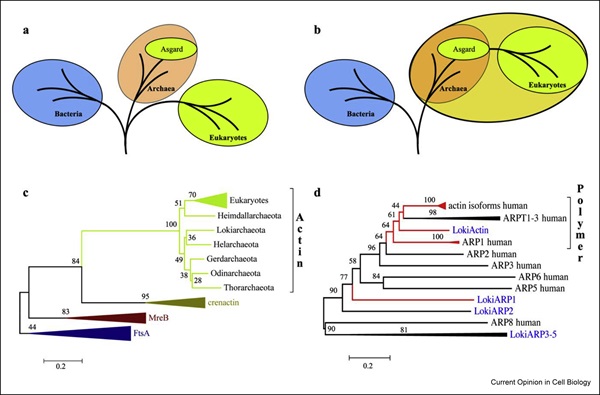The origin of the eukaryotic cell is one of the greatest mysteries in modern biology. Recent sequencing, characterisation and isolation of Asgard archaea opened an intriguing window into the pre-eukaryotic cell. Sequencing of anaerobic sediments identified this group of uncultured organisms, which contain genes homologous to eukaryotic signature genes. Characterisation of the products of these genes at the protein level demonstrated biological processes related to eukaryotes. Isolation produced a model organism in which to study morphological consequences of eukaryotic-like processes. The research team considers the consequences for the Asgard actin cytoskeleton and the evolution of a regulated actin system in the archaea-to-eukaryotic transition.

The origin of the eukaryotic cell is unresolved. A tightly regulated actin cytoskeleton is a hallmark of the eukaryotic cell, where it is often involved in remodelling membranes and cell movement. Asgard archaea possess actin-regulating proteins that have the main attributes of their eukaryotic homologs; however, they are clearly primitive versions of these proteins.
A researcher at the Earth-Life Science Institute (ELSI) at Tokyo Institute of Technology, Caner Akıl (Doctoral student of the National University of Singapore at the time of the research) and Prof. Robert C. Robinson (Okayama University) provided the first biochemical and biophysical data that indicates that Asgard archaea have a functional eukaryotic-like actin regulator protein “profilin” which is one of the main regulators of eukaryotic cytoskeleton. Asgard profilins do not have the classic polyproline binding sites that in eukaryotes would feed the actin/profilin complex into filament nucleation machineries, such as formins. Such actin filament nucleation proteins have yet to be discovered in the Asgard genomes (Akıl & Robinson, 2018, Nature).
Furthermore, these authors showed another main eukaryotic actin regulator gelsolin exists in Asgard archaea. Asgard gelsolins come in many architectures, as one, two, and three copies (recently deposited in GenBank) of the prototypical gelsolin/cofilin domain, a likely record of the gene duplication events that produced the multidomain eukaryotic gelsolins. The many architectures of the Asgard gelsolin proteins, which are often different between phyla, suggest that this family of proteins expanded in Asgard archaea to better control actin function. There is a large increase in the numbers of actin regulators in eukaryotes relative to Asgard archaea: proteins that enhance filament turnover, filament capping and uncapping proteins, filament nucleating proteins, bundling proteins, regulated motors, and post-translational modifications (acetylation), to name a few.
Although these regulators add sophistication to the control of actin, the basic properties of enhanced dynamics and formation of different filament structures can be reproduced by the Asgard actin regulators, properties that were likely important for the archaea-to-eukaryotic transition (Akıl et al., 2020, PNAS). The next steps are to determine whether other actin regulators are present in the large number of “proteins of unknown function” within the expanding numbers of Asgard genomes, and to link the actin cytoskeleton to specific structures and functions in the model organism, MK-D1 which was first cultured Asgard archaea species in the laboratory. The gods of the actin cytoskeleton promise to reveal further compelling insights into the pre-eukaryotic world.
| Journal | Current Opinion in Cell Biology |
| Tile of the paper |
Mythical origins of the actin cytoskeleton |
| Authors | Caner Akıl1,2,a, Yoshihito Kitaoku3,a Linh T. Tran3, David Liebl4, Han Choe5, Duangkamon Muangsaen6, Wipa Suginta6, Albert Schulte6 & Robert C. Robinson1,3,6* |
| Affiliations |
1 Institute of Molecular and Cell Biology, A*STAR (Agency for Science, Technology andResearch), Biopolis, 138673, Singapore 2 Tokyo Institute of Technology, Earth-Life Science Institute (ELSI), Tokyo, 152-8551, Japan 3 Research Institute for Interdisciplinary Science (RIIS), Okayama University, Okayama 700-8530, Japan 4 A*STAR Microscopy Platform, Research Support Center, A*STAR, Biopolis, 138673, Singapore. 5 Department of Physiology, University of Ulsan College of Medicine, Asan Medical Center, Seoul, 05505, Korea 6 School of Biomolecular Science and Engineering (BSE), Vidyasirimedhi Institute of Science and Technology (VISTEC), Rayong 21210 Thailand |
| DOI | 10.1016/j.ceb.2020.08.011 |
| Online published date | October 10, 2020 |
